Carmelite Monks of Wyoming Horarium Contents
Below is the list of sections that make up this page. You can simply read their official Horarium or read about each of the hours of the Carmelite Monk's day.
- Carmelite Monks of Wyoming Horarium
- Matins and Lauds
- Prime
- Mental Prayer
- Terce
- Conventual Mass
- Manual Labor
- Sext
- Noon Meal
- None
- Recreation
- Vespers
- Rosary
- Compline
- Spiritual Reading
Carmelite Monks of Wyoming Official Horarium
The Carmelite Monks of Wyoming Schedule
11:45 p.m. Rise
Midnight Matins/Lauds
1:00 Return to bed
5:45 Rise
6:00 Angelus, Prime
6:25 Mental Prayer/Low Masses
7:25 Terce
7:45 Conventual Mass
8:50 Breakfast followed by work/class
11:40 Sext, Examen
12:00 Angelus, Lunch, followed by None, Dishes
12:45 Recreation
1:30 Class/work
3:00 Litany of our Lady, Chaplet of Divine Mercy
5:00 Vespers
5:30 Mental Prayer
6:30 Angelus, Collation, Dishes
7:15 Rosary, Examen-Compline, Spiritual Reading
8:30 Retire
Carmelite Monks Horarium:
Matins and Lauds
The Midnight Office
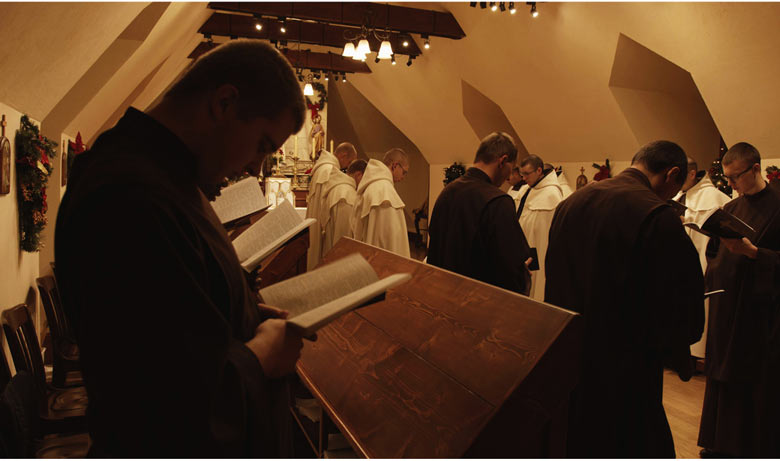
Lost in a deep slumber in the bedchamber of his stone hermitage in the mountains of Wyoming, the choir monk gradually becomes aware of an insistent buzz. Initially confused, he realizes it is the alarm clock, summoning him to the Midnight Office of Matins and Lauds. Washing up and dressing quickly, he pauses before a well-loved picture of Our Lady of Mount Carmel, offering Her his heart and mind as he leaves the hermitage and heads to prayer.
The walk from the hermitage to the interim chapel is only about 500 paces, but the brisk wind and gentle snow makes the monk look forward to building of the Grand Cloister, which will eventually provide a covered walkway between the 24 hermitages and the rest of the monastery. Arriving at the entrance of the monastery, the monk pauses to exchange his mud boots for worn leather sandals. He is soon joined by many other choir monks who prepare likewise for the ascent to the chapel.
Read more about Matins and Lauds here...
The Office of Prime
Morning Office
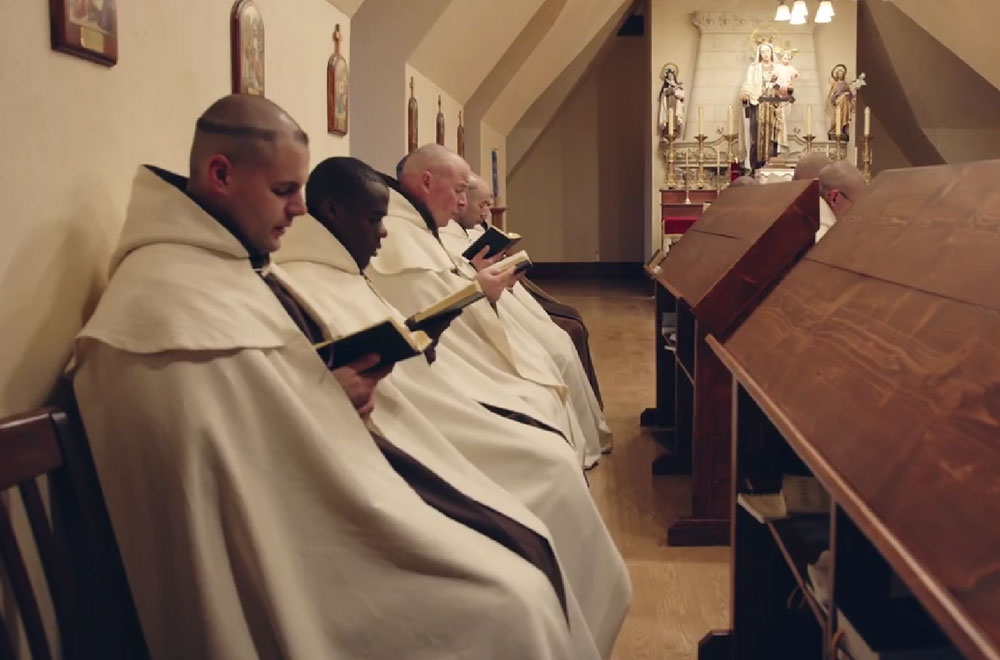
At 5:45 in the morning, the brown-robed monks gradually emerge from their separate hermitages. Each hermitage is named after a Carmelite saint, and has the saint's name carved above the door. First comes one of the priests from his hermitage dedicated to St. John of the Cross, next is a lay brother from the St. Joseph's hermitage, and, from the other side of the grand cloister, comes a professed choir monk from the St. Therese of the Child Jesus hermitage. All the monks are walking purposefully, seemingly unaware of the beautiful sunrise over the eastern horizon. In fact, the monks do notice the sunrise, but now is not the time to stop to appreciate nature: it is time to report to the choir for the Angelus and the office of Prime.
After again exchanging their boots for sandals, the monks file up the wooden staircase in silence to the chapel on the third floor of the monastery. After the customary genuflection and kiss of the Brown Scapular, every monk heads to his place in the choir, prostrating according to the discalced Carmelite tradition. It is 5:55, still five minutes before the Angelus, so there is time to make sure the breviary is set correctly for the office of Prime.
Mental Prayer
Personal Silent Prayer
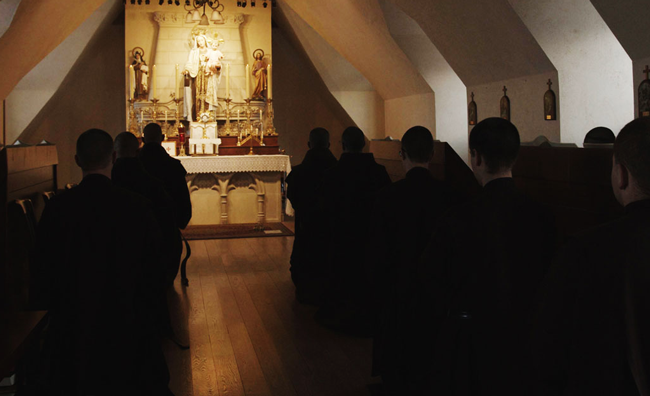
“Veni Sancte Spiritus…” the Prior signals the start of Mental Prayer with an invocation of the Holy Ghost, asking Him to fill the hearts of the faithful monks with the fire of His love. All the lights in the chapel are dimmed, except for those over the altar, which illumine the Tabernacle and the almost-life-size statue of Our Lady of Mount Carmel, who smiles down upon her brothers making mental prayer.
The profound silence of the chapel, rather than being an exterior silence only, seems to radiate outwards from the peaceful souls of the monks, whose hearts are enkindled with love of the Triune God. At times one hears the almost imperceptible turning of a page; the monks do not arrive at mental prayer unprepared, and often bring with them books of the Carmelite Saints, and especially Sacred Scripture, all for the purpose of recollecting deeper and fueling the flame of silent love in their souls.
Read more about Mental Prayer here...
The Office of Terce
The hour prayed before Holy Mass
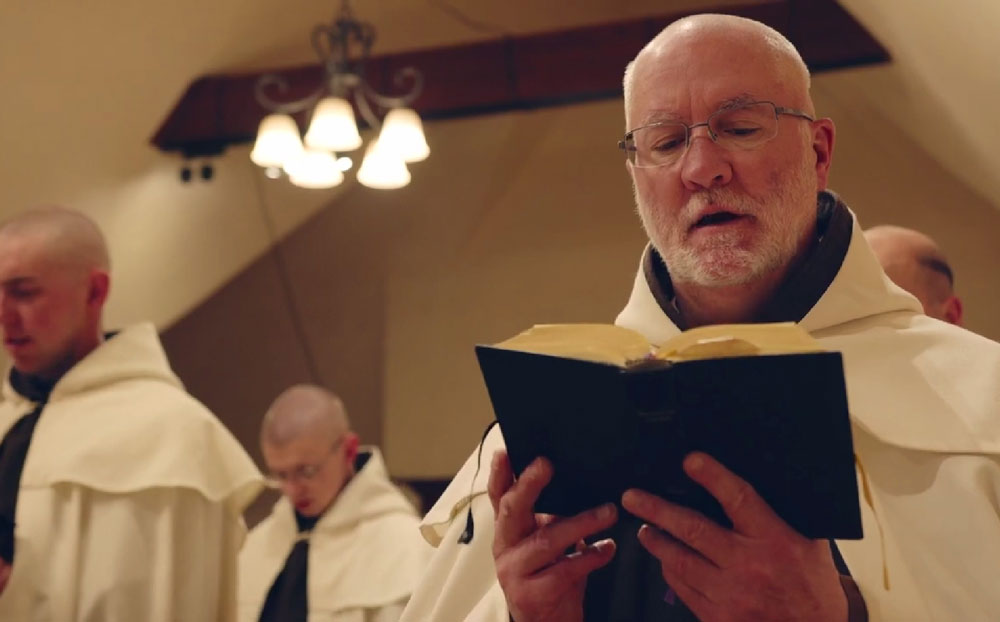
Sunlight fills the chapel as the monks recite the assigned prayers before the Divine Office (commonly known today as the Liturgy of the Hours). Praying for the divine light to fill their intellects and inflame their wills, the monks pause to pray a silent Pater and Ave before the knock and sounding of the pitch pipe initiates the office.
In the Jewish (and Roman) method of counting time, Terce was the third hour of the day, occurring around 3 hours after dawn. Scripture also shows Terce as the hour when the Holy Ghost descended upon Our Lady and the Apostles at Pentecost (See Act 2:1-15). The hymn for Terce (Nunc, Sancte, nobis, Spiritus) recalls the coming of the Holy Ghost and sets the tone for the rest of the office, asking the Holy Ghost to inflame each with a fervent love of God and neighbor.
Terce, as one of the little hours, is fairly brief, lasting between 10 to 15 minutes depending on the length of the psalms assigned for the particular day of the week. After the Salve Regina and the Fidelium are prayed, the Sacristans go to work to prepare for Holy Mass.
Conventual Mass
The daily celebration of a chanted Latin Sung Mass
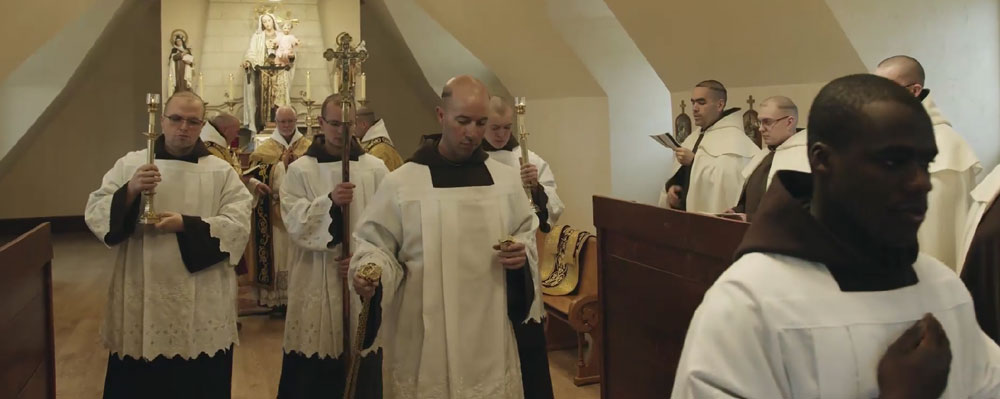
As Terce ends, the brother sacristans begin preparing for Holy Mass. One monk uncovers the altar, while another places the altar cards in their proper place. Meanwhile, the tall candles standing in their ornate gothic stands are lit with a steady hand and long taper. Three chairs are moved from the choir stalls to a section of the chapel closer to the altar; they comprise the sedilia, where the priest and servers will sit, when the rubrics of the Carmelite Rite instruct them to do so.
As the sacristans work to prepare the chapel, the servers are busy in the makeshift sacristy. The thurifer lights his coal, before blowing on it gently, in a small mechanical room that also serves as a work sacristy. The other servers take their surplices from the vesting wardrobe and light the acolyte candles. Meanwhile the priest assigned to offer this conventual High Mass is found before a washroom sink, washing his hands while reciting prayers from a card hung from the wall, imploring God's mercy and praying for purity of body and soul as he prepares to offer Mass.
Read more about Conventual Mass here...
Manual Labor
In Poverty working for the good of the Community
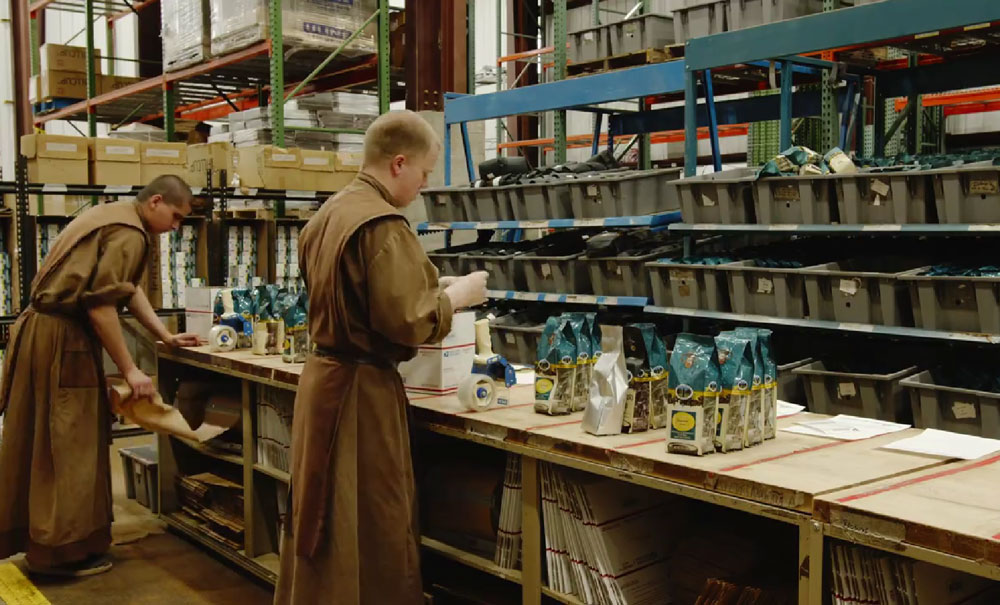
With a staccato rap on the choir stall, the Prior signals that the time has come to leave the chapel and head down the stairs to the Refectory (the monastic dining hall) for breakfast. Upon hearing the knock, all the monks prostrate, and beginning with the youngest monks, line up two-by-two, genuflect and begin processing to the Refectory.
At the same time as the youngest monks begin the procession, the cantor for the week chants the first few words of Psalm 66, “Deus misereatur nostri et benedicat nobis” (May the Lord have mercy on us and bless us). One half of the choir joins in with the cantor, while the other side waits for the next verse. With each side of the choir alternating the chant, the monks process down the three flights of stairs towards the Refectory. Taking a left turn onto the tiled cloisterwalk, they pause the procession for a moment, waiting for the monks at the front of the procession to open the two large cherry-stained doors that open in to the Refectory.
Read more about Manual Labor here...
The Office of Sext
This is the Midday Prayer
Named after the sixth hour in the ancient Jewish / Roman culture, Sext is the third little hour, and is prayed just before lunch. Scripture recounts that the sky went dark on the sixth hour while Jesus was on the Cross. Beginning with the usual prayers before the Divine Office, the two cantors come to the middle of the choir to start the three-verse hymn that is prayed before the three Psalms.
The three Psalms are prayed together under a single antiphon, which changes based on the day of the week. On big feast days the antiphon is taken from the saint's feast day, which adds to the liturgical festivity of the day.
With Sext over, it is time for the Angelus, which is prayed in the chapel on the third floor. When the Angelus bell has finished tolling, the monks process down the stairs to the Refectory for lunch. Unlike the procession after Mass, where the Psalm was chanted, before meals, the De Profundis is recited in a low voice, as the monks pray for their deceased benefactors, family members, and friends.
Noon Meal
Lunch is served in the Refectory
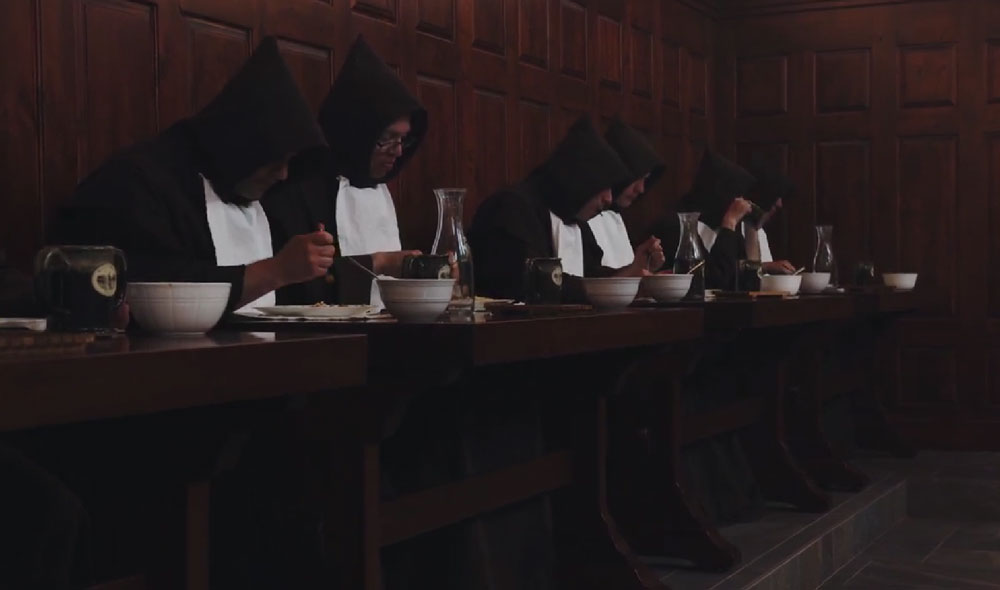
When processing in for lunch, the monk who is assigned the office of lector for the week leaves the procession and heads for a small opening in the wall of the refectory. Inside the opening is a spiral staircase, as steep as it is winding, that leads to a stone platform encircled by a stone railing that looks out over the Refectory. This reading tower allows the lector to project his voice as he reads the Scripture and works of the saints as the other monks eat.
Meanwhile the rest of the community lines up next to their respective places in the refectory for the meal prayers, which are chanted over the course of a few minutes. On a Sunday, the typical meal is that of fish, fresh cooked potatoes and freshly cooked vegetables. The refectorian brothers move from table to table with dishes containing the meal, with each monk taking his food as they stop at his table.
The lector, who is chanting the reading on a single note, is relieved by the second lector, so that the first can eat lunch. A knock on the table signals that lunch is over and the monks chant the after meal prayer, followed by the Miserere Psalm.
The Office of None
Midafternoon Prayer
Chanting the Miserere back and forth between the two choirs, the monks process up the wooden stairs to the chapel. Slightly out of breath after climbing three flights of stairs, the monks finish the Miserere from their places in choir. The after meal prayer finishes, and the monks begin a silent Pater and Ave in preparation for the little hour of None.
After the customary three-verse hymn, the antiphon and Psalms begin, each choir alternating in chanting verses, before rising and bowing at the Gloria Patri that finishes each Psalm. On Fridays, the Psalms for None recall the great mercy of Christ, who deigned to Redeem sinful humanity by offering Himself up on the Cross.
After the ending prayers have been prayed, the monks return to the Refectory to begin washing the pots and pans that were used in the preparation of the meal. Once the dishes are down, one of the monks rings a medium-sized bell: dishes are over, and it is time for recreation.
Community Recreation
The Monks lift the silence and enjoy each other's Company
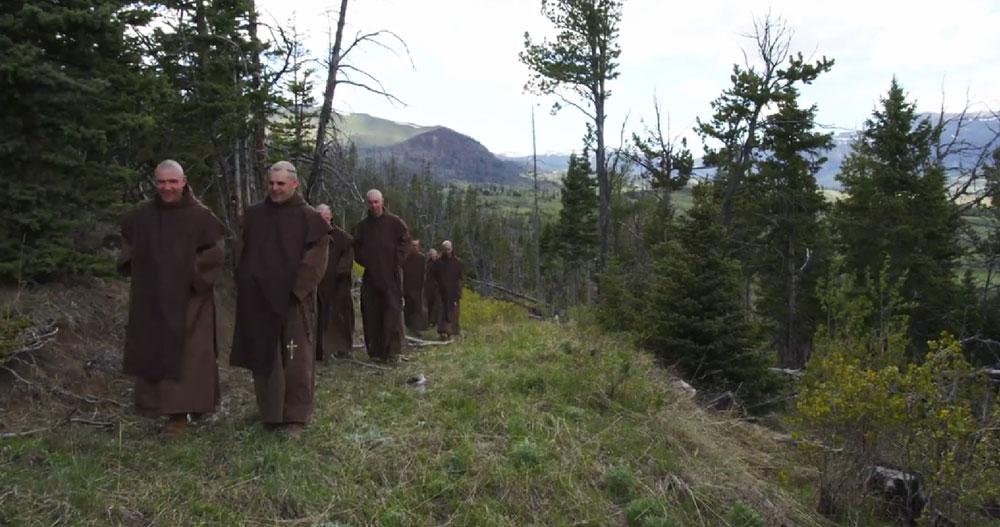
Sometimes recreation is held indoors and other time hiking through the Wyoming mountains. The monks, with silent, smiling faces, proceed to the recreation room, located on the second floor of the monastery, and face the Crucifix. The youngest monk prays the prayer before recreation, and recreation is initiated by the Prior with a joyous Laudetur Jesus Christus! (Praised be Jesus Christ) to which the community responds, Hodie et Semper! (Now and Forever!). The silence of the monastery is lifted, and the monks share their joys and experiences together, interspersed with much jovial laughter.
Arranged in a semi-circle in the recreation room are several wooden benches, each large enough for two monks. Sitting down together the monks move to a more serious spiritual topic, which varies based on the inspiration afforded by the feasts and liturgical season. When the allotted time for recreation ends, the monks rise, face the crucifix and pray a Gloria Patri together. After the Gloria, silence once again fills the monastery. There is time now for a siesta.
Vespers
The most important hour of the day is Evening Prayer
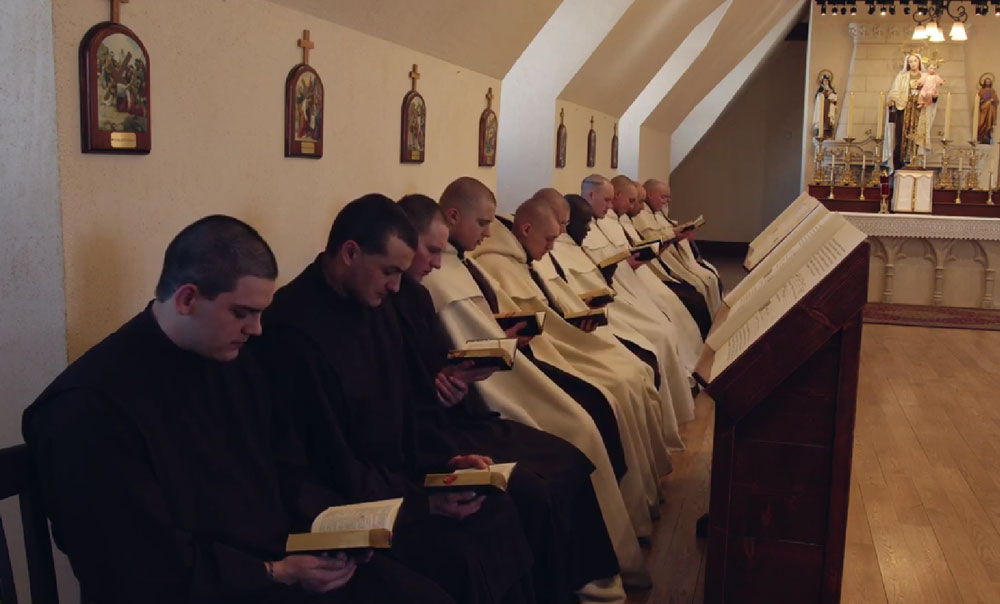
The day's manual labors being finished, the monks wash up and prepare for Vespers. Also know as Evening Prayer, Vespers is the most solemn office prayed each day. On Sundays and solemn feasts the monks happily don the white woolen mantle over their brown choir habits and report to their place in choir with gleaming eyes, rejoicing in anticipation of the great feast that will soon begin.
The monks kneel beside their places in choir, arranging the many ribbons of the breviary as the rubrics for the feast dictates. A younger monk, with his breviary ribbons askew, casts a confused glance at the brother next to him, who silently points to the page numbers. The clock reaches 5:00 and the kneeling Prior knocks on his choir stall. All at once, while crossing their lips, the choir prays “Aperi, Domine, os meum ad benedicendum nomen sanctum tuum...” (Open, O Lord, my mouth, to bless Your Holy Name). After this ancient prayer before office, the monks pray a silent Paterand Ave, recollecting their hearts and renewing their intentions for Vespers.
Read more about Vespers here...
Rosary
The daily Community Rosary
A bell sounds throughout the cloisters of the monastery. The dishes are finished, the sacristans have set the Missal for the next morning's Mass, and it is time for the community Rosary. The monks climb the three flights of stairs on their way to the chapel and genuflect before the tabernacle, each monk kissing his Brown Scapular before prostrating to the floor in front of his choir stall. The chapel is dark, except for the light that illumines the altar and statue of Our Lady of Mount Carmel.
The Prior begins with the Sign of the Cross, and recites the many intentions of the monastery, ending with an intention particularly dear to the hearts of all the monks: Reparation for all the sins, sacrileges and offenses committed against the Sacred Heart of Jesus and Immaculate Heart of Mary. The Rosary proceeds, with a decade offered by the Prior, then the Subprior, and so on down the choir.
Out of their great love for the Blessed Virgin Mary, the monks pray a sixth decade each night, in honor of Our Lady's Immaculate Conception. Once the Rosary is finished, the Prior gives a knock; it is time for the nightly examination of conscience. Each monk prayers for light and asks God pardon for any imperfections. With the examen finished, the lights of the chapel are turned on and Compline begins.
The Office of Compline
Night Prayer and Grand Silence
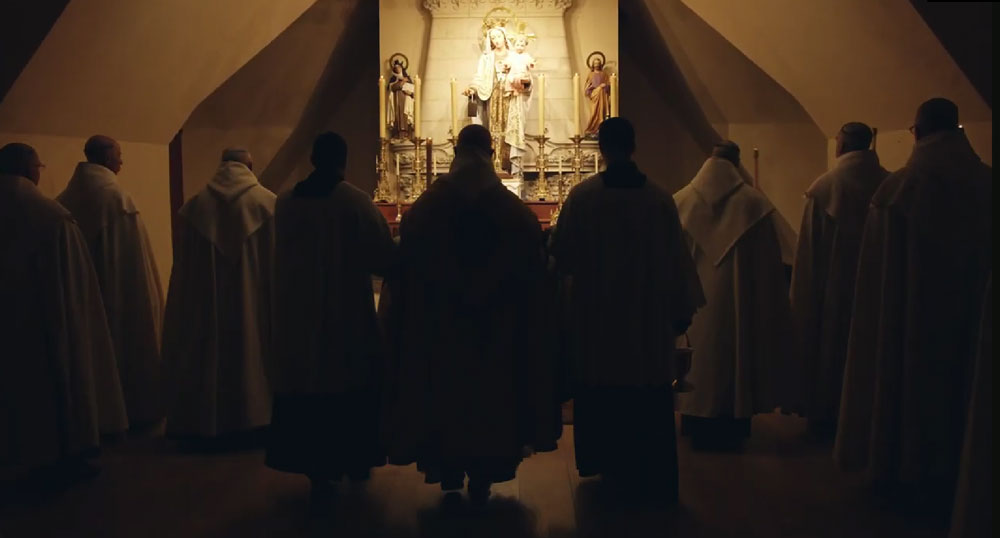
The lector makes his way to the center of the choir, genuflects, and inclines towards the hebdomadary, asking a blessing. He then chants a passage from St. Peter's First Epistle, “Sobrii estote, et vigilate : quia adversarius vester diabolus tamquam leo rugiens circuit, quaerens quem devoret : cui resistite fortes in fide” (Be sober and watch: because your adversary the devil, as a roaring lion, goeth about seeking whom he may devour. Whom resist ye, strong in faith. 1 Pet 5:8-9 DRA).
The antiphons and psalms for Compline change according to the day of the week; on major feast days, however, the Sunday antiphon and psalms are used. Similar to the little hours, Compline has three psalms under a single antiphon, but the hymn occurs after the psalms, rather than before as is the case with the little hours.
Towards the end of Compline there is an aspersion from the hebdomadary, who sprinkles the entire choir with Holy Water, as all chant the first verses of Psalm 50, the Miserere. Compline ends with a final Fidelium, chanted by the Prior in a low tone. After a silent, Pater, Ave. and Credo, the monks receive a final blessing from the Prior, and retreat to their hermitages, hoods up and eyes recollected, as they seek to make good use of the final minutes of the day.
Spiritual Reading
Meditative Reading in the Hermitage
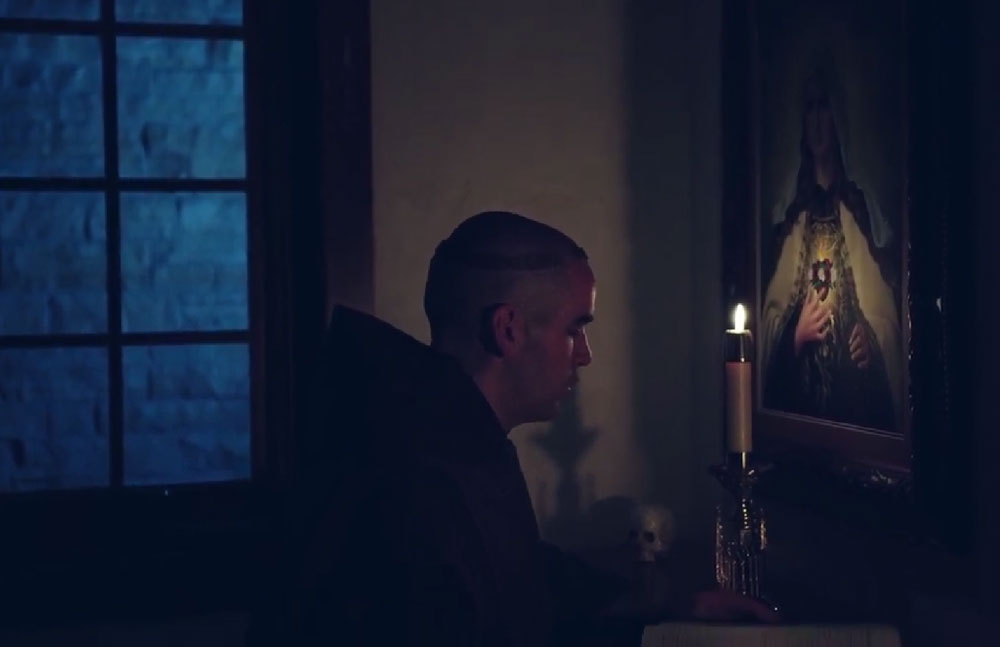
Once in his hermitage, the monk takes up his spiritual reading, which might be a work of St. Teresa or St. John of the Cross, or perhaps he is rereading Story of a Soul. When the small clock in his hermitage reads 8:30, he extinguishes the dim hermitage light and retires peacefully to bed for a few hours rest before the Horarium of the next day begins, just as it did this day, at 11:45pm, when he will go once more to the Midnight Office.
Learn more about the Carmelite Monks of Wyoming here.
Read more about the Carmelite Vocation here.